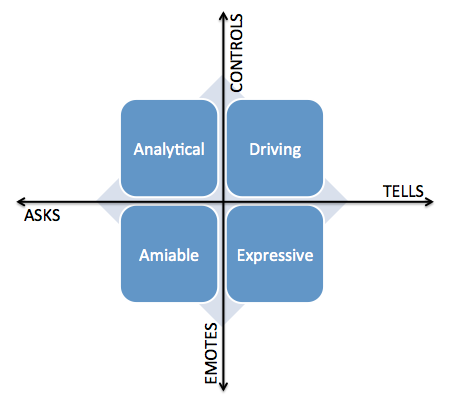As my patient pool grows, the dentistry doesn’t change much, but the person in my chair changes every day. I connect with most patients pretty well, but every now and then I am presented with a challenge. What I would call a difficult patient has nothing to do with the dentistry required in their mouth. The difficulty comes from the patient interaction. I know myself, I know the dentistry, but there is something missing in my understanding of the patient.
I received some insight from one of my attendings at my GPR program, who is also an L.D. Pankey Institute faculty member. He introduced me to the Social Styles Model, which is taught at the Pankey Institute along with the concept of relationship based dentistry. Our discussion led me to the TRAMCOM Group website. Here they elaborate on the specifics of the Social Styles Model.
In the 1960s Roger Reid and John Merrill created the Social Styles Model to help predict human interactions in business relationships. They identified three variables that determine a person’s social style: assertiveness, responsiveness, and versatility. Within these behavioral dimensions four social styles emerged: analytical, amiable, driving, and expressive.
Responsiveness is determined by how much you control or reveal your emotions. Assertiveness is based on where you fall in the spectrum of ask versus tell, or lead versus follow.
No one social style is better than the others, and each style has its own pros and cons. Once you get familiar with each social style, you will begin to pick up on clues that tell you which style your patient uses. Here are four unique behavioral patterns recognized in the Social Style Model, according to The TRACOM Group:
 Driving style patients control their emotions and speak assertively. These people want to know the facts about their treatment. Be direct and practical regarding their problems and treatment options. They are focused on the end result and want to know you have a plan.
Driving style patients control their emotions and speak assertively. These people want to know the facts about their treatment. Be direct and practical regarding their problems and treatment options. They are focused on the end result and want to know you have a plan.
Amiable style patients show their emotions and prefer to ask questions than give orders. These patients are friendly and ask questions because it makes them feel more comfortable. Take the time to talk with them and get personal. It will definitely pay off.
Analytical style patients control their emotions and prefer to ask questions than give orders. They ask questions because they want to know all of the details. They want to understand each step, the cost, and maybe even the number of appointments. They appreciate precision and accuracy. Take time to develop their treatment plan to show that you care about these things too.
Expressive patients show their emotions and speak assertively. These patients will share their thoughts and feelings regarding their dental problems, but may need your direction. Let them speak, you listen, and then help them focus on their needs.
The next time you have a challenging or difficult patient, look at this social style chart and see where they belong. If you understand why a patient is behaving a certain way, then this may help you alter your social style to make the interaction successful and prevent frustration. This is where versatility comes in. Versatility is primarily the responsibility of the dentist in the patient-doctor relationship. A versatile dentist can alter their social style to make the patient more comfortable. This requires a certain level of awareness and compassion for the patients social needs, not just their dental needs.
I can easily recall patients that fit each social style. Seeing them through this lens makes me like them better as people, and I will definitely change how I interact with them at our next appointment.
Dr. Carolyn Norton is a New Dentist Now guest blogger and a 2014 graduate of the University of Florida College of Dentistry. She is in a 12-month general practice residency at the North Shore University Hospital in Evanston, Ill., affiliated with the University of Chicago. Dr. Norton was a contributing editor for the American Student Dental Association from 2012-14.


I really appreciate you sharing your insight on this, Carolyn. We so often forget that no two people are the same, and this means that they will interact differently too. We should pay more attention to the patient’s personality and behavior instead of just the file. Thanks for sharing!
Thanks for this post . we found very useful information hare about Dentistry.Good to know about the dentists and the various technologies that have made the dentistry advanced and modern and better.Thanks for sharing. Here some useful
Thanks for this post!! definitely very useful
That truly is an important part of being a great dentist, patient connection. The problem is that it needs to reciprocal. There is only so much you can do if the patient doesn’t care for the connection.
Nice article, with a good view. Thank you.. 🙂
Such a great post! Gave me a lot to think about. Thanks!
A very good resource for everybody that wants to read a good blog.
This is a great article. Very helpful when dealing with patients. Everyone communicates in their own way and acknowledging the different styles that people express themselves through communication can save a lot of trouble along the line. I would say that this is also useful for anyone who has to deal with the general public or clients on a regular basis.
I use these techniques in my practice. My daughter is a pediatric dentist and she has some cool insight as well. With kids, sometimes it’s tough to reason, so you have to be expressive in other ways.